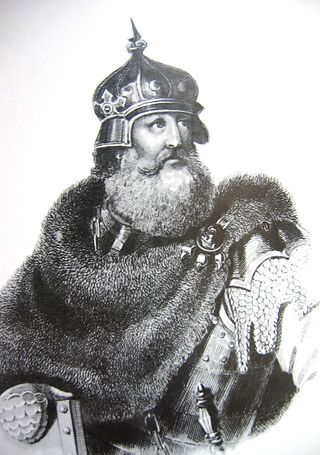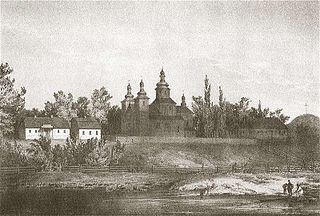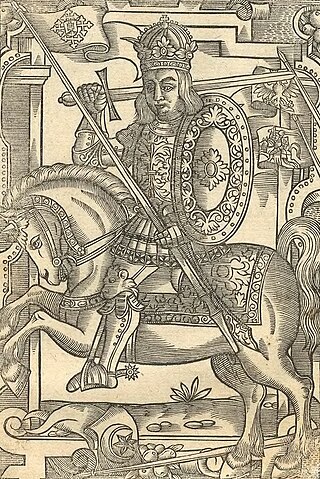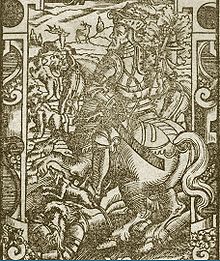Morta was Queen of Lithuania (1253–1262) upon the accession of her husband, King Mindaugas. Very little is known about her life. Probably, Morta was Mindaugas' second wife as Vaišvilkas, the eldest son of Mindaugas, was already a mature man active in international politics when Morta's sons were still young and dependent on the parents. After her death, Mindaugas married her sister, the wife of Daumantas. In revenge, Daumantas allied with Treniota and assassinated Mindaugas and two of Morta's sons in 1263.

The Grand Duchy of Lithuania was a sovereign state in northeastern Europe that existed from the 13th century, succeeding the Kingdom of Lithuania, to the late 18th century, when the territory was suppressed during the 1795 partitions of Poland–Lithuania. The state was founded by Lithuanians, who were at the time a polytheistic nation of several united Baltic tribes from Aukštaitija. By 1440 the grand duchy had become the largest European state, controlling an area from the Baltic Sea in the north to the Black Sea in the south.

Kęstutis was sole Duke of Trakai from 1342 to 1382 and Grand Duke of Lithuania from 1342 to 1382, together with his brother Algirdas, and with his nephew Jogaila.
Erdvilas was one of the 21 early dukes of Lithuania who signed a treaty with Galicia–Volhynia in 1219. He and Vykintas are the two dukes of Samogitia mentioned in the treaty. This is supported by the fact that the eastern part of Samogitia supported King of Lithuania Mindaugas, while the western part, ruled by Vykintas, was more hostile. That is the only mention of him in written sources. Few historians consider that Treniota, Mindaugas' nephew, was son of Erdvilas. However more prefer Vykintas as Treniota's father.
Shvarn or Shvarno was Grand Duke of Lithuania from 1267 to 1269. He was also the prince of Kholm from 1264 to 1269. An influential leader, he became involved in internal struggles of power within the neighboring Grand Duchy of Lithuania.

Vaišvilkas or Vaišelga was Grand Duke of Lithuania from 1264 until his death in 1267. He was a son of Mindaugas, the first and only Christian King of Lithuania.

The Catholic Church in Lithuania is part of the worldwide Catholic Church, under the spiritual leadership of the Pope in Rome. Lithuania is the world's northernmost Catholic majority country. Pope Pius XII gave Lithuania the title of "northernmost outpost of Catholicism in Europe" in 1939. The Vilnius Cathedral is the most important Catholic Church in Lithuania, which was previously used for the inauguration ceremonies of Lithuanian monarchs with Gediminas' Cap, while in modern times it is a venue for masses dedicated to the elected Presidents of Lithuania after their inauguration ceremonies and giving of oaths to the Nation in the Seimas Palace.

The Kingdom of Lithuania was a sovereign state that existed from the 17 July 1251 until the death of the first crowned king of Lithuania, Mindaugas, on 12 September 1263. Mindaugas was the only Lithuanian monarch crowned king with the assent of the Pope and the head of the first catholic Lithuanian state. The formation of the kingdom is widely regarded as a partially successful attempt at unifying all surrounding Baltic tribes, including the Old Prussians, into a single unified state under a common king.

Vykintas was Duke of Samogitia and a rival to the future King of Lithuania, Mindaugas. In 1236 he probably led the Samogitian forces in the Battle of Saule against the Livonian Order. The Order suffered a great defeat and was near the brink of collapse, forcing it to become a branch of the Teutonic Knights.

The Battle of Skuodas or Schoden was a medieval battle fought in ca. 1259 near Skuodas in present-day Lithuania during the Lithuanian Crusade. The Samogitian army of 3,000 invaded Courland and on their way back defeated the Livonian Order, killing 33 knights and many more low-rank soldiers. In terms of knights killed, it was the eighth largest defeat of the Livonian Order in the 13th century. This victory led to a Semigallian insurrection against the Livonian crusaders, which lasted from 1259 to 1272.

The Battle of Durbe was a medieval battle fought near Durbe, 23 km (14 mi) east of Liepāja, in present-day Latvia during the Livonian Crusade. On 13 July 1260, the Samogitians soundly defeated the joint forces of the Teutonic Knights from Prussia and the Livonian Order from Livonia. Some 150 knights were killed, including Livonian master Burkhard von Hornhausen and Prussian land marshal Heinrich Botel. It was by far the largest defeat of the knights in the 13th century: in the second-largest, the Battle of Aizkraukle, 71 knights were killed. The battle inspired the Great Prussian Uprising and the rebellions of the Semigallians, the Couronians, and the Oeselians. The battle undid two decades of Livonian conquests and it took some thirty years for the Livonian Order to restore its control.

The House of Mindaugas was the first royal family of Grand Duchy of Lithuania, centered on Mindaugas, the first known and undoubted sovereign of Lithuania. He was crowned as King of Lithuania in 1253 and assassinated ten years later. His known family relations end with children; there is no data on his great-grandchildren or any relations with the Gediminids, a dynasty of sovereigns of Lithuania and Poland that started with Butigeidis ca. 1285 and ended with Sigismund II Augustus in 1572.
Lengvenis was one of the local dukes in the early Grand Duchy of Lithuania during the reign of King Mindaugas (1230s–1263). First mentioned in 1242, Lengvenis was a nephew of Mindaugas.

The Christianization of Lithuania occurred in 1387, initiated by King of Poland and Grand Duke of Lithuania Jogaila and his cousin Vytautas the Great. It signified the official adoption of Catholic Christianity by Lithuania, the last pagan country in Europe. This event ended one of the most complicated and lengthiest processes of Christianization in European history.

Mindaugas was the first known grand duke of Lithuania and the only crowned king of Lithuania. Little is known of his origins, early life, or rise to power; he is mentioned in a 1219 treaty as an elder duke, and in 1236 as the leader of all the Lithuanians. The contemporary and modern sources discussing his ascent mention strategic marriages along with banishment or murder of his rivals. He extended his domain into regions southeast of Lithuania proper during the 1230s and 1240s. In 1250 or 1251, during the course of internal power struggles, he was baptised as a Roman Catholic; this action enabled him to establish an alliance with the Livonian Order, a long-standing antagonist of the Lithuanians. By 1245, Mindaugas was already being referred to as "the highest king" in certain documents. During the summer of 1253, he was crowned king, ruling between 300,000 and 400,000 subjects, and got nicknamed as Mindaugas the Sapient by the Livonians.
The history of Lithuania between 1219 and 1295 concerns the establishment and early history of the first Lithuanian state, the Grand Duchy of Lithuania. The beginning of the 13th century marks the end of the prehistory of Lithuania. From this point on the history of Lithuania is recorded in chronicles, treaties, and other written documents. In 1219, 21 Lithuanian dukes signed a peace treaty with Galicia–Volhynia. This event is widely accepted as the first proof that the Baltic tribes were uniting and consolidating. Despite continuous warfare with two Christian orders, the Livonian Order and the Teutonic Knights, the Grand Duchy of Lithuania was established and gained some control over the lands of Black Ruthenia, Polatsk, Minsk, and other territories east of modern-day Lithuania that had become weak and vulnerable after the collapse of Kievan Rus'.

Vytenis was Grand Duke of Lithuania from c. 1295 to c. 1316. He became the first of the Gediminid dynasty to rule for a considerable amount of time. In the early 14th century, his reputation outshone that of Gediminas, who is regarded by modern historians as one of the greatest Lithuanian rulers. The rule of Vytenis was marked by constant warfare in an effort to consolidate the Grand Duchy of Lithuania with the Ruthenians, Masovians, and the Teutonic Order.

The Lithuanian Crusade was a series of campaigns by the Teutonic Order and the Livonian Order under the pretext of forcibly Christianizing the pagan Grand Duchy of Lithuania. The Livonian Order occupied Riga in 1202 and in the 1230s they settled in Chełmno Land, a fief of Poland. They first conquered other neighboring Baltic tribes—Curonians, Semigallians, Latgalians, Selonians, and Old Prussians—in the Livonian Crusade and Prussian Crusade.














